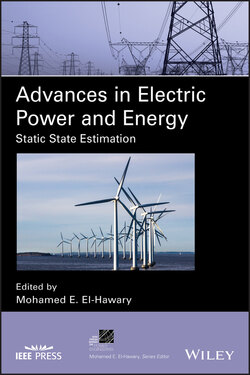Читать книгу Advances in Electric Power and Energy - Группа авторов - Страница 16
1.2 DEFINING SSE
ОглавлениеIn 1974, Schweppe and Handschin [5] described state estimation (SE) using the following metaphor: “The life blood of the control system is a base of clean pure data defining the system state and status (voltages, network configuration). This life blood is obtained from the nourishment provided by the measurements gathered from around the system (data acquisition). A static state estimator is the digestive system which removes the impurities from the measurements and converts them into a form which the brain (man or computer) of the central control system can readily use to make ‘action’ decisions on system economy, quality, and security.”
Reference [1] formally defines the static state of an electric power system as the vector of voltage magnitudes and angles at all network buses. The static state estimator (SSE) is a data processing algorithm for converting imperfect redundant meter readings and other available information to an estimate of the static state.
Item 603‐02‐09 of the International Electrotechnical Commission (IEC) Electropedia [6] offers the following definition of “state estimation” as “the computation of the most probable currents and voltages within the network at a given instant by solving a system of mostly nonlinear equations whose parameters are obtained by means of redundant measurements.”
The North American Electric Reliability Corporation (NERC) Real‐Time Tools Best Practices Task Force (RTBPTF) 2008 final report [7] offers the following definition: “A state estimator is an application that performs statistical analysis using a set of imperfect, redundant, telemetered power‐system data to determine the system's current condition. The system condition or state is a function of several variables: bus voltages, relative phase angles, and tap changing transformer positions. A state estimator can typically identify bad analog telemetry, estimate non‐telemetered flows and voltages, and determine actual voltage and thermal violations in observable areas.”
According to [5], SSE has evolved rapidly to online implementations beginning with the Norwegian Tokke installation [8] followed by the larger AEP installation [9] soon after. Not long later, T. E. Dy Liacco [10] stated: “Although the number of control centers with State Estimation is still rather small, the number is increasing at a rapid rate. The requirement for State Estimation at a modern control center has become the rule, rather than the exception.”
The fundamental problem of state estimation can be defined as an over determined system of nonlinear equations solved as an unconstrained weighted least squares (WLS) minimization problem. The WLS estimator minimizes the weighted sum of the squares of the residuals. Residuals are the error or difference between the estimated and the actual values [11]. Many papers and books treat the broad generic area of “state estimation” in system theory [12–14]. State estimation concepts can be applied in other power systems areas [15–20].
